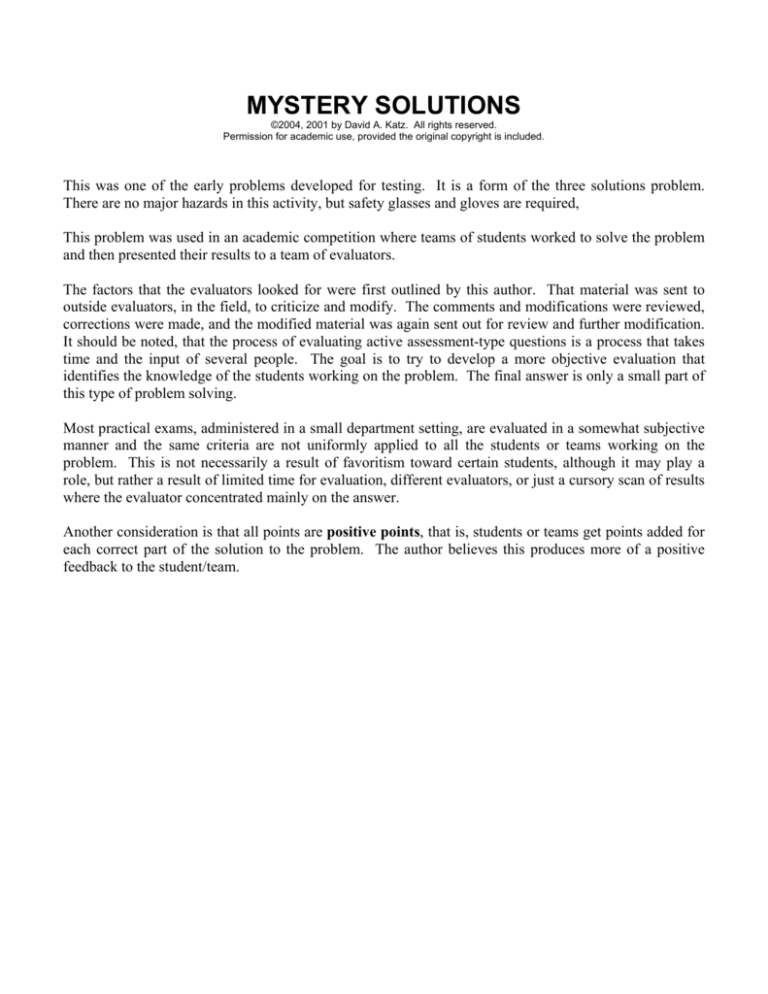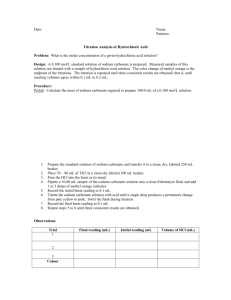
MYSTERY SOLUTIONS
©2004, 2001 by David A. Katz. All rights reserved.
Permission for academic use, provided the original copyright is included.
This was one of the early problems developed for testing. It is a form of the three solutions problem.
There are no major hazards in this activity, but safety glasses and gloves are required,
This problem was used in an academic competition where teams of students worked to solve the problem
and then presented their results to a team of evaluators.
The factors that the evaluators looked for were first outlined by this author. That material was sent to
outside evaluators, in the field, to criticize and modify. The comments and modifications were reviewed,
corrections were made, and the modified material was again sent out for review and further modification.
It should be noted, that the process of evaluating active assessment-type questions is a process that takes
time and the input of several people. The goal is to try to develop a more objective evaluation that
identifies the knowledge of the students working on the problem. The final answer is only a small part of
this type of problem solving.
Most practical exams, administered in a small department setting, are evaluated in a somewhat subjective
manner and the same criteria are not uniformly applied to all the students or teams working on the
problem. This is not necessarily a result of favoritism toward certain students, although it may play a
role, but rather a result of limited time for evaluation, different evaluators, or just a cursory scan of results
where the evaluator concentrated mainly on the answer.
Another consideration is that all points are positive points, that is, students or teams get points added for
each correct part of the solution to the problem. The author believes this produces more of a positive
feedback to the student/team.
MYSTERY SOLUTIONS
(Student instructions)
Materials:
•
•
•
•
•
3 Beral pipettes labeled A, B, and C
one contains a calcium chloride solution
one contains a sodium carbonate solution
one contains dilute hydrochloric acid solution
Well plate
Scissors
Safety glasses
Gloves
NOTE: Read all instructions before you begin. All students must wear safety
glasses and gloves during experimentation.
Task:
Using the materials provided, you team has 20 minutes to design and perform a chemistry experiment to:
Identify the contents of each pipette.
Provide the equations for the chemical reactions that identify the solutions.
Note: The pipette tips have been heat sealed. Use the scissors to cut off the sealed pipette tips.
After 20 minutes, you will give a 5-minute presentation for the evaluators explaining your observations
and conclusions. Because you will be judged on your depth of knowledge, be sure to include appropriate
scientific terminology.
All members of your team must participate in the presentation.
MYSTERY SOLUTIONS
ANSWER KEY & EXPLANATION
Materials
3 Beral pipettes labeled A, B, and C
one contains a calcium chloride solution, CaCl2
one contains a sodium carbonate solution, Na2CO3
one contains dilute hydrochloric acid solution, HCl
Well plate (24 or 48 wells)
Scissors
Safety glasses
Gloves
Task
Given the names of the compounds, identify the contents of each pipette.
Note: The pipette tips have been heat sealed. Use the scissors to cut off the sealed pipette tips.
Reactions
By mixing the three solutions in pairs, the students should be able to identify the three solutions.
Hydrochloric acid reacts with sodium carbonate to produce carbon dioxide gas (bubbles)
The chemical reactions that occur are:
2 HCl + Na2CO3 → 2 NaCl + H2CO3
hydrochloric sodium
sodium carbonic
acid
carbonate
chloride
acid
and the carbonic acid is unstable and decomposes:
H2CO3 → CO2 ↑ + H2O
Carbonic carbon water
Acid
dioxide
Note: The arrow ↑ indicates that CO2 is a gas
These two reactions can be combined and written as:
2 HCl + Na2CO3 → 2 NaCl + CO2 ↑ + H2O
hydrochloric sodium
sodium carbon water
acid
carbonate
chloride dioxide
Calcium chloride reacts with sodium carbonate to produce calcium carbonate, a white precipitate, which is observed
as a cloudy mixture.
CaCl2 + Na2CO3 → CaCO3 ↓ + 2 NaCl
Calcium sodium
calcium
sodium
Chloride carbonate carbonate chloride
Note: The arrow ↓ indicates formation of a
precipitate
There is no reaction when the hydrochloric acid and the calcium chloride are mixed
HCl + CaCl2 → no reaction
Hydrochloric calcium
acid
chloride
Mystery Solutions
MASTER SCORESHEET
TOTAL of 500 points
Demonstration (160 points)
Students should demonstrate that:
A. One combination of 2 solutions produces gas (bubbles)
_____40 pts
B. One combinations of 2 solutions produces a precipitate
_____40 pts
C. One combinations of 2 solutions produces no reaction
_____40 pts
Students should identify all 3 solutions correctly.
calcium chloride, CaCl2 is in pipette A
sodium carbonate, Na2Co3 is in pipette C
hydrochloric acid, HCl is in pipette B
_____40 pts
(Note) No points are awarded for combining 3 solutions, since that doesn’t aid
in the identification of the 3 solutions.
SUBTOTAL POINTS (160 Max.)
___________
Explanation/Presentation (300 points)
A. hydrochloric acid + sodium carbonate
sodium chloride + carbonic acid
1) For writing a correct chemical equation:
2 NaCl + H2CO3
2 HCl + Na2CO3
and
_____30 pts
H2CO3 → CO2 ↑ + H2O
or
2 HCl + Na2CO3
2 NaCl + CO2
+ H 2O
2) If they indicate that CO2 is a gas, using the notation CO2 (g) or CO2
______5 pts
3) If they that carbonic acid, H2CO3, is unstable and breaks down to
form CO2
______10 pts
4) If the equation is properly balanced
______10 pts
5) Add five points for each formula that is correct up to a maximum
of (25) twenty-five points
______25 pts
6) For a correct oral explanation of the reaction
______50 pts
B. calcium chloride + sodium carbonate
calcium carbonate +sodium chloride
1) For writing a correct chemical equation:
CaCO3 ↓ + 2 NaCl
CaCl2 + Na2CO3
______25 pts
2) If the equation is properly balanced
______10 pts
2) Add (5) five points for each formula that is correct up to a maximum
of (20) twenty points
______20 pts
3) Add (5) points if they indicate the CaCO3 is a precipitate using
the notation CaCO3 (s) or ↓
______5 pts
4) For a correct oral explanation of the reaction
______50 pts
C. hydrochloric acid + calcium chloride
no reaction
1) For writing the correct chemical equation:
HCl + CaCl2
no reaction (or N.R.)
______20 pts
2) Add (5) five points for any formula that is correct up to a maximum
of (10) ten points
______10 pts
3) For a correct oral explanation of the reaction
______30 pts
SUBTOTAL POINTS (300 Max.)
____________
Presentation (40 points)
For all team members actively participating in the presentation.
(20 pts Max.)
__________
(20 pts Max.)
__________
SUBTOTAL POINTS (40 Max.)
__________
TOTAL POINTS (500 Max.)
__________
Use of general public speaking skills such as voice projection,
eye contact, proper grammar, etc.








